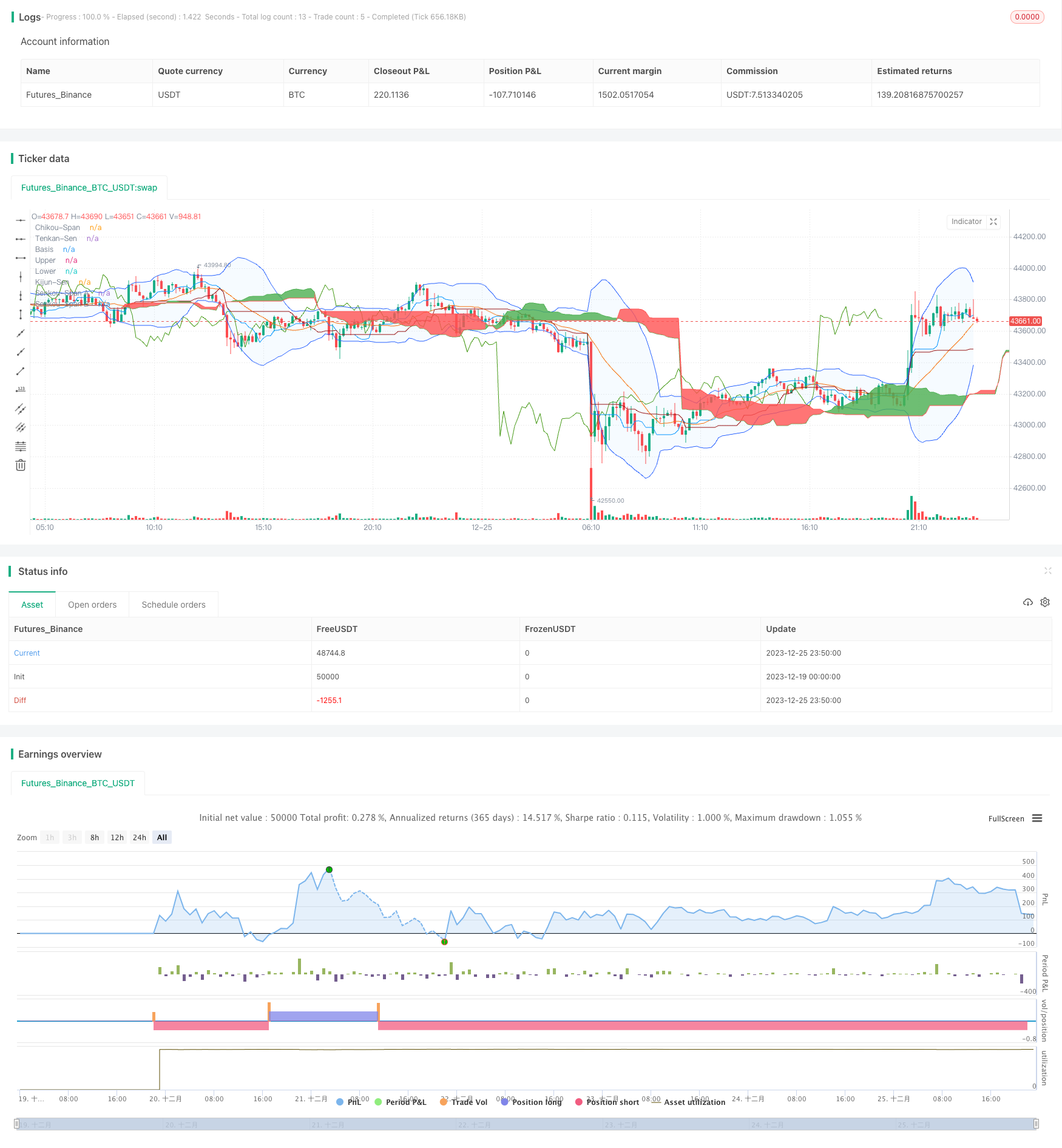
概述
本策略将一种日本指标一云图与布林带指标组合,形成交易信号,进行多空判断。策略可以有效判断市场趋势,并在布林带指标发出多空信号时进行判断,避免错误交易。
策略原理
一云图由转换线、基准线、延迟线、先行线组成。转换线为9日均线,基准线为26日均线。当转换线在基准线之上时为多头信号,反之为空头信号。
延迟线即价格的延迟移动。当延迟线在上方时表示多头趋势,下方为空头。
云带由两条先行线组成,分别为52日均线和26日均线的均值。价格在云带之上视为多头,下方为空头。
布林带由n日均线及标准差构成,为股价波动带。当价格突破上带时看多,下破下带时看空。
本策略在一云图发出多空信号时,同时判断布林带的突破,形成交易规则。如转换线向上突破基准线,延迟线在上方,价格突破云带,并突破布林带上带时,为做多信号。
策略优势
一云图判断趋势清晰,转换线和延迟线可判断短期趋势,云带判断中长期趋势方向。
布林带判断价格是否过冲,可有效过滤掉部分不必要交易。
组合指标,使交易信号更加清晰可靠,避免交易风险。
风险及优化
布林带参数设置不当可能导致交易信号不准确。应根据不同标的谨慎设置参数。
应适当调整持仓比例以控制风险。持仓过大可能导致亏损扩大。
可以考虑加入止损策略,在价格向不利方向运行超过一定幅度时止损。
可以测试更多指标与一云图进行组合,形成更可靠的交易策略。
总结
本策略有效利用一云图判断趋势方向和布林带指标过滤信号。策略信号较为清晰可靠,通过参数调整和止损优化,可以降低交易风险,获得较好收益。
策略源码
/*backtest
start: 2023-12-19 00:00:00
end: 2023-12-26 00:00:00
period: 10m
basePeriod: 1m
exchanges: [{"eid":"Futures_Binance","currency":"BTC_USDT"}]
*/
// This source code is subject to the terms of the Mozilla Public License 2.0 at https://mozilla.org/MPL/2.0/
// © Coinrule
//@version=5
strategy("Ichimoku Cloud and Bollinger Bands",
overlay=true,
initial_capital=1000,
process_orders_on_close=true,
default_qty_type=strategy.percent_of_equity,
default_qty_value=30,
commission_type=strategy.commission.percent,
commission_value=0.1)
showDate = input(defval=true, title='Show Date Range')
timePeriod = true
notInTrade = strategy.position_size <= 0
//Ichimoku Cloud
//Inputs
ts_bars = input.int(9, minval=1, title="Tenkan-Sen Bars")
ks_bars = input.int(26, minval=1, title="Kijun-Sen Bars")
ssb_bars = input.int(52, minval=1, title="Senkou-Span B Bars")
cs_offset = input.int(26, minval=1, title="Chikou-Span Offset")
ss_offset = input.int(26, minval=1, title="Senkou-Span Offset")
long_entry = input(true, title="Long Entry")
short_entry = input(true, title="Short Entry")
middle(len) => math.avg(ta.lowest(len), ta.highest(len))
// Components of Ichimoku Cloud
tenkan = middle(ts_bars)
kijun = middle(ks_bars)
senkouA = math.avg(tenkan, kijun)
senkouB = middle(ssb_bars)
// Plot Ichimoku Cloud
plot(tenkan, color=#0496ff, title="Tenkan-Sen")
plot(kijun, color=#991515, title="Kijun-Sen")
plot(close, offset=-cs_offset+1, color=#459915, title="Chikou-Span")
sa=plot(senkouA, offset=ss_offset-1, color=color.green, title="Senkou-Span A")
sb=plot(senkouB, offset=ss_offset-1, color=color.red, title="Senkou-Span B")
fill(sa, sb, color = senkouA > senkouB ? color.green : color.red, title="Cloud color")
ss_high = math.max(senkouA[ss_offset-1], senkouB[ss_offset-1])
ss_low = math.min(senkouA[ss_offset-1], senkouB[ss_offset-1])
// Entry/Exit Conditions
tk_cross_bull = tenkan > kijun
tk_cross_bear = tenkan < kijun
cs_cross_bull = ta.mom(close, cs_offset-1) > 0
cs_cross_bear = ta.mom(close, cs_offset-1) < 0
price_above_kumo = close > ss_high
price_below_kumo = close < ss_low
//Bollinger Bands Indicator
length = input.int(20, minval=1)
src = input(close, title="Source")
mult = input.float(2.0, minval=0.001, maxval=50, title="StdDev")
basis = ta.sma(src, length)
dev = mult * ta.stdev(src, length)
upper = basis + dev
lower = basis - dev
offset = input.int(0, "Offset", minval = -500, maxval = 500)
plot(basis, "Basis", color=#FF6D00, offset = offset)
p1 = plot(upper, "Upper", color=#2962FF, offset = offset)
p2 = plot(lower, "Lower", color=#2962FF, offset = offset)
fill(p1, p2, title = "Background", color=color.rgb(33, 150, 243, 95))
bullish = tk_cross_bull and cs_cross_bull and price_above_kumo and ta.crossover(lower, close)
bearish = tk_cross_bear and cs_cross_bear and price_below_kumo and ta.crossover(close, lower)
strategy.entry('Long', strategy.long, when=bullish and long_entry and timePeriod)
strategy.close('Long', when=bearish and not short_entry)
strategy.entry('Short', strategy.short, when=bearish and short_entry and timePeriod)
strategy.close('Short', when=bullish and not long_entry)
//Works well on BTC 30m/1h (11.29%), ETH 2h (29.05%), MATIC 2h/30m (37.12%), AVAX 1h/2h (49.2%), SOL 45m (45.43%)